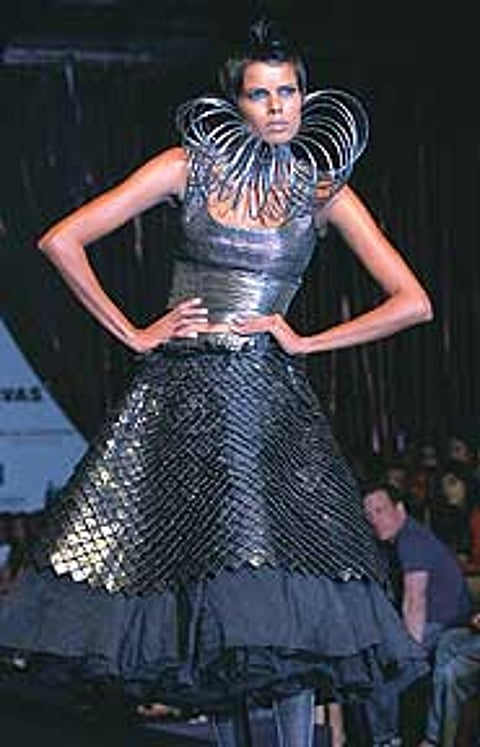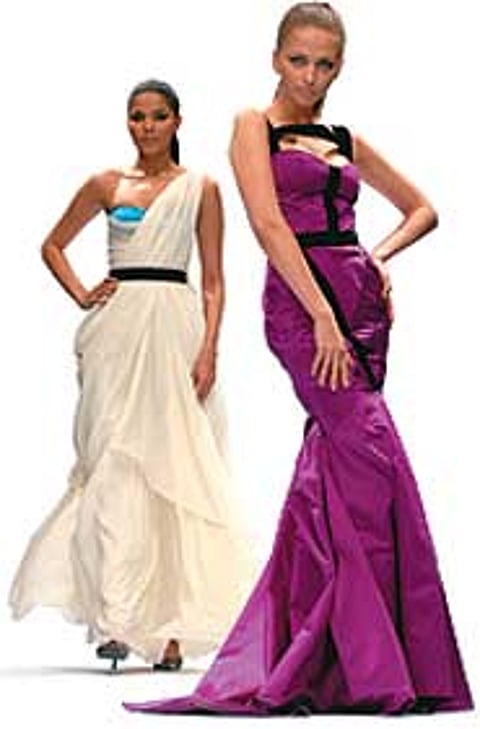Ole! Ole! The Heir Apparel
Seeing is disbelieving? Indian fashion adds some new visual accents.
- Metallic Tones: Burnt copper, bronze, gold, silver
- Jewel Colours: Emerald green, topaz yellow, turquoise, and amethyst purple
- Form: Fitting, architectural silhouettes
- Texture: Worked in through beads or sequins
***

Joan of Arc: A clingy metallic corset from Rohit Bal |
As executive director, FDCI, Sumeet Nair, puts it, "I can unequivocally say that qualitatively, we have the best set of trade representatives this year: buyers, agents, the influentsia, the opinionmakers. Also, we'd never had foreign PR and sales agents before and they're especially powerful." They're a great facilitator for Indian newcomers to the international fashion arena; plugged in as they are into buyer tastes and the reigning fashion trends of New York, Milan, London and Paris. Adds Nair, "They have a multiplier effect. One sales agent translates into 50 or 60 new buyers!"
The impressive line-up includes Milanese boutique Biffi, New York-based Henri Bendel, Galaries Lafayette from Paris, as well as a clutch of enormously influential tastemakers, including fashion blogger Scott Schuman, renowned for his inspirational photos of stylish people walking the streets of New York, Stockholm and Paris, and Patrick Cabasset, fashion editor of L'Officiel.
With such a discerning, well-heeled crowd at the fashion week, it's easy to see why the FDCI has gone to such lengths to ensure they're well-entertained between shows. They can recharge with shiatsu massages and salon visits, feed on smoked salmon or amuse themselves at the Chivas VIP lounge, which pumps out raucous club music and tipsy socialites throughout the day.
Fashion week opened with Vikram Phadnis' imprecation to save the environment, delivered through a group of black-clad dancers, going through callisthenic moves onstage as drums thundered ominously. Immediately afterward, the models trooped onto the ramp with their extraterrestrial stylings - foil horns, theatrical make-up and stunned expressions. Their clothes were less memorable: embroidered flowery tops, black draped shawls and ruched skirts - sort of ET-meets-Bavarian peasant.
While most spectators were merely bemused, one funkily attired buyer with gay ribbons woven through her hair stared with mounting mortification as each model swooped past. The richly textured tunics and capes of Payal Jain's Black Earth collection, heavy on greys and browns, shown on day two, were a rather more fetching elegy to environmental destruction.
Suneet Varma, on the other hand, turned his gaze to the East, citing "Kabuki paintings and the haunting Memoirs of a Geisha" as the inspirations behind his form-fitting, metallic toned jackets, coats and breeches which were embellished with oriental applique motifs. Kavita Bhartia glammed up the gypsy look with scarves and gold cuffs setting off sweeping, luxurious silk skirts.

Gauri & Nainika's romantic creation |
A rarer flock of celebrities showed up for the Rohit Bal show, which had the hall bursting at the seams: sarod playing brothers Amaan and Ayan Ali, crossdressing hairdresser Sylvie and management guru Arindam Chaudhuri with his trademark ponytail and Swarovski crystal spectacles. The show was spectacular and lavish. As Bal himself proclaims, "The collection is dramatic and for the most part unwearable." The highlights were clingy armour-like corsets, glimmering shifts, dramatically flounced and rippled skirts in metal-toned gota fabric.
While experienced designers have each struck upon a successful formula they keep rejigging, it's the new crop that's eager to move away from kurtis and saris, to experiment with fabrics and push new non-Indian silhouettes.
"As designers, we've changed, we've moved towards non-Indian references," says 23-year-old Prashant Verma, trained at Alexander McQueen, Galliano and Dior, whose collection is inspired by the youthful destructive rage of James Dean. Thumbing through his collection of delicate hand-dyed bandages draped into classic Hollywood gowns, he remarks, "We're catering to global citizens for whom fashion is not defined by cultural identity."
The immensely talented 25-year-old designer Varun Sardana, last season's best new designer, also cites inspirations that veer sharply away from Indian references: French poet Baudelaire and origami folds. Varun's collection mixes disparate elements into a "quirky, slightly dysfunctional but beautiful" result - fusing sequins and sportswear elements together in evening wear, for instance.
FDCI czarina Rathi Vinay Jha says fabric, not innovation, is the Indian USP, "We're known for our quality, hand-worked weaves, printing, and embroidery. The craft skills that embellish and add value." It's up to the younger crop to make a garment's worth be measured by the quality of its design, rather than its weight in sequins and ornamentation.
Tags